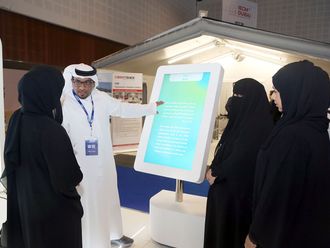Scientists have found evidence that an advanced society existed at least 7,500 years ago in what is now the UAE, it was announced yesterday.
Studies of a man's skeleton, discovered in March on Marawah Island, 70km west of Abu Dhabi, have revealed its great age.
Archaeologists said the stone building in which he lived and was buried, and the pottery found next to him, was evidence that an organised community with building skills lived here 7,500 years ago.
Other clues illustrate the lifestyle and diet of the person.
The skeleton was found during excavations directed by Dr Mark Beech, senior resident archaeologist of the Abu Dhabi Islands Archaeological Survey (Adias).
During work at Site MR-11 as many as six stone buildings in a village were found. In one of them a human skeleton was entombed on a stone platform.
Colonel Ahmad Hassan Al Awadi, director of the Forensic Science Laboratory at Abu Dhabi Police General Headquarters, said radiocarbon dating and the associated finds proved the skeleton was about 7,500 years old.
"This makes the skeleton, and the building in which it was found, the earliest evidence yet found of the presence of man in the UAE.
"Preliminary studies suggest that the man was between 20 and 40 years old when he died. The cause of death has yet to be discovered."
Peter Hellyer, executive director of Adias, said the findings were bound to change perceptions about ancient civilisations along the Gulf coast.
"The 15-cm pot that was believed to have been made in western Iran and southern Iraq showed that the settled community had done business with neighbouring peoples.
"The head of the skeleton, which faced eastwards showed they observed burial rituals because they believed that since the sun rises in the east it gives life, so the face should be pointed that way.
"They were not primitive. They lived a healthy life, feeding on dates, meat, fish and other seafoods.
"They kept domestic sheep and goats, harvested plants to feed their animals, collected mangrove and hunted dugongs and turtles among other marine mammals.
"This disproves claims that the UAE was nothing but a group of Bedouins until oil was discovered."
The sex of the skeleton was determined by the recovery of ancient DNA, or deoxyribonucleic acid the substance that forms the chemical blueprint of all living things.
Dr Saeed Shawgi, head of the Forensic Pathology Unit at Abu Dhabi Police, said the study of the UAE's oldest human remains was the first time that archaeologists from the Adias had combined their skills with those of scientists from the police Forensic Science Laboratory.
"The skeleton was not well-enough preserved. However, among parts of the skeleton that were preserved were several teeth and three of these have been examined by the Forensic Science Laboratory and the Forensic Pathology Unit at Abu Dhabi Police Headquarters.
"Although the ancient DNA was not well preserved, using the latest forensic science techniques, the Forensic Laboratory was able to determine that the skeleton was a male from its DNA profile," Dr Shawgi said.
Further research on the skeleton is continuing, and Adias plans a season of archaeological excavations at the site in March and April.
The Adias work on Marawah is carried out in association with the Environmental Research and Wildlife Development Agency, which is responsible for the conservation of Marawah and adjacent islands as well as the surrounding seas, as part of the Marawah Marine Protected Area.
More information about the recent work conducted by Adias can be found by logging on to www.adias-uae.com, or www.adias-uae.com/ marawah.html as well as www.adias-uae.com/mr11.html.









